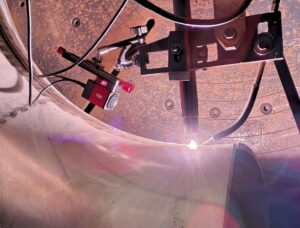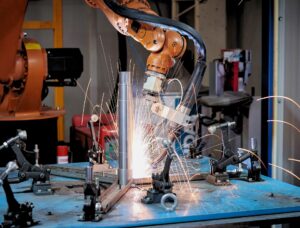How Welding Cameras Boost Productivity in Automated Welding Lines by integrating with robotic welding systems to ensure efficiency, accuracy, and weld quality.
Automation has transformed modern manufacturing, and welding is no exception. Robotic welding is now a cornerstone of industries like automotive, aerospace, and heavy fabrication, where speed and precision are critical. But automation alone isn’t enough—monitoring weld quality in real time is essential to avoid costly weld problems and downtime.
That’s where welding cameras come in. Integrated into automated welding lines, these advanced systems ensure operators maintain visibility, accuracy, and control without interrupting the process.
The Challenge of Automated Welding
Automated systems excel at consistency, but they face challenges such as:
- Weld Defects like porosity, undercutting, or slag inclusion going unnoticed during production.
- Limited Visibility in processes like metal arc welding, plasma arc welding, or MIG and MAG welding.
- Downtime caused by stopping robotic systems for manual checks or corrections.
Without advanced monitoring, even automated systems risk compromised welding quality.
How Welding Cameras Improve Efficiency
By integrating weld monitoring camera into robotic systems, manufacturers can achieve real-time control and higher throughput.
1. Real-Time Arc Monitoring
High-speed optics capture clear arc welding images, even in environments with intense light and fumes, allowing immediate detection of weld defects.
2. Seam Tracking and Adjustment
Cameras help robotic welders align precisely with weld joints. In applications like MIG welding or TIG welding (tungsten inert gas), accurate tracking reduces errors and rework.
3. Reduced Downtime
Instead of halting production for welding inspection, operators can monitor continuously. This minimizes interruptions and increases line efficiency.
4. Data Recording for Traceability
Video records of every weld provide valuable documentation for welding inspection techniques, quality audits, and compliance requirements.
Real-World Applications
- Automotive Manufacturing – Mig Mag welding lines rely on cameras for spot-checking thousands of joints without slowing production.
- Aerospace Fabrication – Precision-driven projects use laser welding cameras to ensure defect-free results.
- Shipbuilding & Heavy Fabrication – Cameras help track long welds in large structures while keeping operators at a safe distance.
The Future of Automated Welding with Cameras
As welding technology advances, cameras will play a bigger role in smart manufacturing. With AI-powered analytics, weld monitoring systems will automatically detect anomalies and make corrective adjustments in real time. This means safer, faster, and more accurate production across industries.
Conclusion: How Welding Cameras Boost Productivity in Automated Welding Lines
Automated welding lines are only as efficient as their monitoring systems. By integrating advanced welding cameras, manufacturers reduce downtime, improve welding quality, and boost overall productivity.
For industries striving for efficiency, accuracy, and safety, partnering with a trusted welding camera manufacturer ensures your robotic systems deliver consistent, high-quality results—every time. Contact us now for more information.



